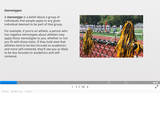
Slideshow about stereotypes
- Subject:
- Career and Technical Education
- Criminal Justice
- Material Type:
- Interactive
- Provider:
- Michigan Virtual
- Date Added:
- 06/26/2019

Slideshow about stereotypes

Fraud and Arson Slideshow
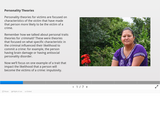
Personality Theories Slideshow
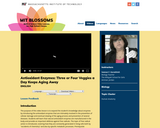
The purpose of this video lesson is to expand the student's knowledge about enzymes by introducing the antioxidant enzymes that are intimately involved in the prevention of cellular damage and eventual slowing of the aging process and prevention of several diseases. Students will learn that natural antioxidant enzymes are manufactured in the body and provide an important defense against free radicals. The topic of free radical action is introduced, covering how they are constantly generated in living cells both by ''accidents of chemistry'' and also by specific metabolic processes.

This set of cards can be used in a workshop or a "Maker Faire" type of event. They give quick tidbits of code for building mini-apps with App Inventor. Use them in exhibits, parent nights, STEM fairs, after-school clubs, or anywhere that you need to get people jump-started using App Inventor.
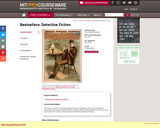
This course focuses on works that caught the popular imagination in the past or present. It emphasizes texts that are related by genre, theme or style. The books studied in this course vary from semester to semester, and the topic for Fall 2006 is Detective Fictions.
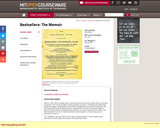
What is a "life" when it's written down? How does memory inform the present? Why are memoirs so popular? This course will address these questions and others, considering the relationship between biography, autobiography, and memoir and between personal and social themes. We will closely examine some recent memoirs: Tobias Wolff's This Boy's Life, Barack Obama's Dreams From My Father, Edwidge Danticat's Brother, I'm Dying, Ayaan Hirsi Ali's Infidel, and Alison Bechdel's Fun Home. Students will write two brief papers: a critical essay and an experiment in memoir.As a "Sampling," this class offers 6 units, with a strong emphasis on close reading, group discussion, focused writing, and research and presentation skills.
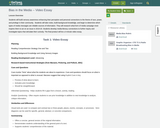
Students will build sensory awareness enhancing their perception and personal connections to the theme of race, power, and privilege in their community. Students will take notes, build background knowledge, and begin to determine which types of media messages are reliable sources of information. They will research what form of media campaign most inspires them to act on an issue in 2019-20. Students develop media-literacy connections to further inquiry and investigate topics that stimulate their curiosity. The final product will be a 3-minute video essay.
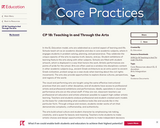
In the EL Education model, arts are celebrated as a central aspect of learning and life. Schools teach art as an academic discipline and also in core academic subjects, where it engages students in problem solving, planning, and perseverance. They celebrate the unique capacity of the arts to express truth, beauty, and joy. Student exhibitions of learning feature the arts along with other subjects. Schools are filled with student artwork, which is displayed in a way that honors the work. Artistic performances are points of pride for the school. Arts are often used as a window into disciplinary content in other academic subjects (e.g., ancient Greek architecture as an entry point to ancient Greek civilization, protest songs as a case study when learning about the civil rights movement). The arts also provide opportunities to explore diverse cultures, perspectives, and regions of the world.
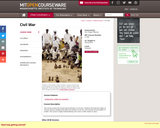
This course surveys the social science literature on civil war. Students will study the origins of civil war, discuss variables that affect the duration of civil war, and examine the termination of conflict. This course is highly interdisciplinary and covers a wide variety of cases.

In an increasingly interconnected world, communicating across cultures is a crucial skill in the international networks of business, science, and technology. Subject examines a range of communication styles and techniques resulting from different cultural norms and traditions. It begins with a general theoretical framework and then moves into case studies. Topics include understanding the relationship between communication and culture, differences in verbal and non-verbal communication styles, barriers to intercultural communication, modes of specific cross-cultural communication activities (e.g. argumentation, negotiation, conflict resolution) and intercultural adjustment. Case studies explore specific ways of communicating in Asian and European cultures. Graduate students are expected to complete additional assignments. Taught in English.It has become commonplace knowledge that globalization is one of the major forces shaping our world. If we look at the spread of information, ideas, capital, media, cultural artifacts--or for that matter, people--we can see the boundaries and borders that have historically separated one country or one group from another are becoming more and more permeable. For proof of this close to home, you need only to look at the composition of the MIT student body: 8 percent of the undergraduates and 37 percent of the graduate students are from 109 different countries. "Communicating Across Cultures" is designed to help you meet the challenges of living in a world in which, increasingly, you will be asked to interact with people who may not be like you in fundamental ways. Its primary goals are to help you become more sensitive to intercultural communication differences, and to provide you with the knowledge and skills that will help you interact successfully with people from cultures other than your own. We hope the course will accomplish those goals by exposing you to some of the best writers and scholars on the subject of intercultural communication, and by giving you a variety of opportunities to practice intercultural communication yourself. As you read the syllabus for this course, we hope you get a sense of our commitment to making this course a rewarding experience for you.
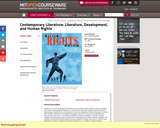
Subject focuses on fiction, drama, and poetry and possibly films inspired by these topics mostly of the 1960s, 1970s, and 1980s.
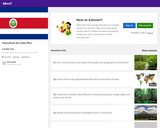
While using this object, students are introduced to new information about Costa Rica. It is reinforced with short facts and questions, and reviewed to strengthen their new knowledge of the concept. Students can access Kahoot from a computer or mobile device. As the teacher displays questions on the screen, students answer from their devices, and are given instant feedback. Percentages of each answer chosen are then displayed on the screen. As a bonus, students can later play in "Ghost Mode" to review the material and beat their score.
The object addresses the following world language standards:
2.1.M.G.a Recognize important features of country(s) where language is spoken
2.1.M.G.c Identify major geographic features (rivers, mountains, deserts, forests)
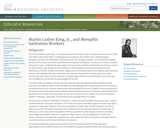
This lesson provides fliers and other documents related to the demonstration in Memphis on March 28, 1968. On that day, students near the end of the march broke windows of businesses. Looting ensued. The march was halted. King was deeply distressed by the violence. He and fellow leaders negotiated a commitment to nonviolence among disagreeing factions in Memphis, and another march was planned for April 8. On April 4, as he stepped out of his motel room to go to dinner, he was assassinated.
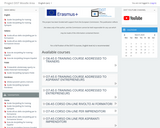
Here you can find a Guide, addressed to teachers on the use of storytelling and of the videos produced for training purposes, within the project DIST.
An E-course addressed to trainers on how to enhance the sense of initiative and entrepreneurship in their students,
2 E-courses, one addressed to aspirant entrepreneurs and one addressed to entrepreneurs, to enhance their sense of initiative and entrepreneurship.
Some Videos featuring young and valuable European managers telling their professional history.
Other information about the DIST project here www.distproject.eu
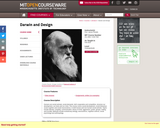
Humans are social animals; social demands, both cooperative and competitive, structure our development, our brain and our mind. This course covers social development, social behaviour, social cognition and social neuroscience, in both human and non-human social animals. Topics include altruism, empathy, communication, theory of mind, aggression, power, groups, mating, and morality. Methods include evolutionary biology, neuroscience, cognitive science, social psychology and anthropology.
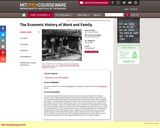
Explores the changing map of the public and the private in pre-industrial and modern societies and examines how that map affected men's and women's production and consumption of goods and leisure. The reproductive strategies of women, either in conjunction with or in opposition to their families, is another major theme. How did an ideal of the "domestic" arise in the early modern west, and to what extent did it limit the economic position of women? How has it been challenged, and with what success, in the post-industrial period? Focuses on western Europe since the Middle Ages and on the United States, but some attention to how these issues have played themselves out in non-Western cultures. This course will explore the relation of women and men in both pre-industrial and modern societies to the changing map of public and private (household) work spaces, examining how that map affected their opportunities for both productive activity and the consumption of goods and leisure. The reproductive strategies of women, either in conjunction with or in opposition to their families, will be the third major theme of the course. We will consider how a place and an ideal of the "domestic" arose in the early modern west, to what extent it was effective in limiting the economic position of women, and how it has been challenged, and with what success, in the post-industrial period. Finally, we will consider some of the policy implications for contemporary societies as they respond to changes in the composition of the paid work force, as well as to radical changes in their national demographic profiles. Although most of the material for the course will focus on western Europe since the Middle Ages and on the United States, we will also consider how these issues have played themselves out in non-western cultures.
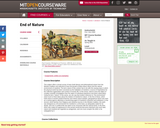
A brief history of conflicting ideas about mankind's relation to the natural environment as exemplified in works of poetry, fiction, and discursive argument from ancient times to the present. What is the overall character of the natural world? Is mankind's relation to it one of stewardship and care, or of hostility and exploitation? Readings include Aristotle, The Book of Genesis, Shakespeare, Descartes, Robinson Crusoe, Swift, Rousseau, Wordsworth, Darwin, Thoreau, Faulkner, and Lovelock's Gaia. This subject offers a broad survey of texts (both literary and philosophical) drawn from the Western tradition and selected to trace the growth of ideas about nature and the natural environment of mankind. The term nature in this context has to do with the varying ways in which the physical world has been conceived as the habitation of mankind, a source of imperatives for the collective organization and conduct of human life. In this sense, nature is less the object of complex scientific investigation than the object of individual experience and direct observation. Using the term "nature" in this sense, we can say that modern reference to "the environment" owes much to three ideas about the relation of mankind to nature. In the first of these, which harks back to ancient medical theories and notions about weather, geographical nature was seen as a neutral agency affecting or transforming agent of mankind's character and institutions. In the second, which derives from religious and classical sources in the Western tradition, the earth was designed as a fit environment for mankind or, at the least, as adequately suited for its abode, and civic or political life was taken to be consonant with the natural world. In the third, which also makes its appearance in the ancient world but becomes important only much later, nature and mankind are regarded as antagonists, and one must conquer the other or be subjugated by it.

Drag and Drop Correct Months French Activity
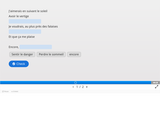
Drag and Drop Song Lyrics